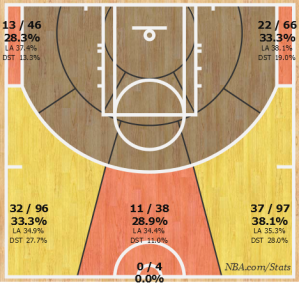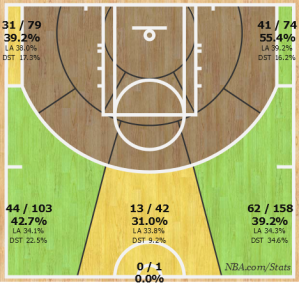Over the past several seasons, Danny Green has carved out a role for himself on the San Antonio Spurs. He is a high-level perimeter defender, forming one of the most potent two-man wing defending duos in the NBA with Kawhi Leonard, and he’s a solid spot-up shooter. While his offensive game may not be incredibly layered, Green is the very embodiment of a “3-and-D” player. During the 2015-2016 season, however, Green’s three-point percentage fell lower than it has since his rookie year, making only 33.2% of his three point attempts. What initially seemed like a minor cold streak in November continued to plague him through the end of the regular season. Initially, it looked like Green had corrected the issue in January, shooting 49.1% from three-point range that month, but his three-point shooting fell by over 10% each month for the next two months, landing at 25.8% for March.
There is reason, however, to be optimistic for a strong, bounce-back year from Green. Last year, Green’s usage rate, or the percentage of a team’s possessions ended by a given player through shooting a field goal, shooting free throws, or turning the ball over, was the lowest it’s been in his career at 14.6%. While some of his usage rate drop probably occurred after the shooting slump was apparent, at least some of the decline in usage can be attributed to the emergence of Leonard as an elite offensive threat and the addition of LaMarcus Aldridge to the squad. Suddenly, there were less plays drawn for Green and less actions run for him simply due to the fact that there were more elite offensive threats suiting up for the Spurs than had in several years. Many of the times, when Green would get a shot, it would be the result of a broken play, where the primary and secondary options were covered and Green happened to be the open man. This meant that Green was receiving the ball at different times and in different places than he was accustomed to. While this may not sound like an issue that would cause a significant drop in one’s shooting, NBA-level shooters hone their craft primarily through repetition. The more variables that change, whether that’s when the shooter receives the ball or where the shooter receives the ball, the more difficult the shot becomes.
According the NBA’s official stat page, unlike most players who would prefer to shoot from the corners, Green has almost always been more comfortable shooting from either the left or the right of the key. Last season (shot chart to left), he shot 55.7% of his threes from those areas after attempting 57.1% of his threes from those zones the year before. While he was less efficient in both spots, significantly so on the left side. Green only shot 1.1% worse to the right of the key last year, more efficient than any of the other five zones the NBA tracks. The corners were a more obvious areas of weakness this past season. After shooting 55.4% from the right corner two seasons ago (shot chart to right), Green only shot 33.3% from the same corner last season, almost 5% lower than league average.

As stated before, there is reason to believe that Green will bounce back this season. First, Green received LASIK eye surgery over the summer, meaning there was a good chance that his eyes were bothering him throughout the season. If that’s the case, receiving this surgery alone should give a boost to Green’s shooting this season. If that wasn’t enough, Green’s shooting was much better in the postseason. While only having a sample size of 10 games, Green shot 50% against the Memphis Grizzlies and Oklahoma City Thunder. When the Spurs signed Aldridge, Spurs Head Coach Gregg Popovich had to redesign a lot of the offensive playbook that the Spurs had used for past several seasons. The entire Spurs’ offense should be expected to run a bit smoother this season with the Spurs more familiar with Aldridge and vice versa, meaning that Green will likely be more incorporated into the offense this season than he was last. If Green were to return to form, the other four players on the court would benefit from the spacing produced. While his calling card has always been defense, don’t be surprised if Green re-emerges this season as a 3-point threat.
Statistics used via Basetball-Reference.com unless stated otherwise.
Add The Sports Daily to your Google News Feed!
